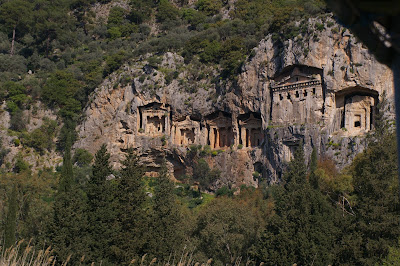
Here are pictures of the tombs I promised you. The bottom picture was taken from our hotel room balcony in Dalyan.
These are referred to as “Lycian temple tombs,” though as it happens these particular tombs are in Caria, and are part of the necropolis of Kaunos, a once-great city whose ruins are now accessible only by water.
The Lycians, and I guess the Carians, began building elaborate tombs in the 4th Century BCE. These began with distinctive “house tombs” (top photo), with the inside arranged as a miniature home for the deceased. Then the “houses” were moved into small rock-cut tombs on the cliff face, and then more elaborate tombs began to be built in the shape of temples.
Note that the largest and most elaborate tomb hasn’t been finished. We’ve been making up stories about why it was abandoned, and why workers never went back to it. Also, if you look to the upper right of the abandoned tomb, you’ll see another temple tomb that was roughed in but never actually started.
These particular tombs were inaccessible, but we were able to enter some of the spectacular tombs in the Lycian city of Tloss. (Patricia, who grew up on Roger Corman films, was particularly thrilled.) Each tomb had niches for exactly three bodies.
Why three? Why these tombs at all? History does not tell us: the structures themselves, long looted, are the only evidence.
By the way, if you’ve never heard of Lycia and Caria, don’t feel embarrassed. Nothing really ever happened there— no history at all in its conventional sense, meaning conquests, battles, famous leaders, etc. The area was (and remains) rich, protected by the natural walls of the Tauros mountains to the north, and by the Mediterranean to the south. The people there were wealthy in their isolation, concentrated on making money and living the good life, and then leaving a beautifully-housed corpse.
I expect this area will inspire a number of stories from me. If only I can find time to write them.


“Note that the largest and most elaborate tomb hasn’t been finished. We’ve been making up stories about why it was abandoned, and why workers never went back to it.”
Why did the people not go back to the Lycian tomb? Because the Lycian was not dead, he was a werewolf! How could people named the Lycans not be dog people? While you are there, watch out for the vampires as well.
PS. Fantastic pictures, even better history. I find it sad that most necropolises (Necropoli?) have such a dead nightlife.
PPS. The real reason why the tomb was not finished was that the man and his two wives ran out of money.
“I will have to post a picture once I get home.”
PPPS. Welcome back!
I’m not convinced that “nothing ever really happened” in Lycia. After all Alexander the Great conquered it in 334 – 3 BC and I imagine that that was quite memorable. Subsequently it was under Roman and Byzantine rule – but I’m not too hot on the details.
From the 11th century on the region was conquered by various Turkic peoples, culminating in the Ottoman conquest in the 13th century.
In 1923 was the Greco-Turkish War, which ended with the new Turkish Republic expelling all the Anatolian Christians (nominally ‘Greeks’) and the Greeks deporting all of their Muslims (‘Turks’) – this was a lamentable example of 20th century ethnic cleansing, which had a profound effect on both Turkey and Greece.
Then there was my visit in the 1990s in which I got lost several times, walked into an armed road-block in the middle of the night (luckily the police were checking cars, not pedestrians), photographed most of the local flora and saved a tortoise’s life (it had fallen on its back); I’m sure that all of this is recorded in the local annals somewhere … possibly?
Wow. That’s a great hotel-room view. Neat stuff; thanks for sharing it.
Wow, those are cool, and a not very well known piece of history.
But there is a lot of stuff like that, if you only look.
Until the invasion of Iraq, for instance, I had never heard of the Yazidi. Now, if I were a SF writer, they would be awesome fodder for the template of an outre culture for a story or a novel.
Well, Dave, if you were there, then we can be sure that Lycia has a History.
(I think I ran into that armed roadblock, by the way. And several others. We never got stopped, I wonder what they were looking for.)
Alexander the Great didn’t go to a lot of effort to conquer Lycia: the Lycians surrendered as soon as he turned up. Just as they surrendered to the Hittites, the Cretans, the Persians, the Greeks, the Rhodians, and later to Brutus and Cassius, to Antony and Octavius, to Octavius on his own, and apparently to any tinpot general with a rusty sword and a pair of sandals.
Why spoil a good thing by going to war? They always negotiated good terms for themselves, and went on living the good life.
Yes, I agree, under certain circumstances surrender may well be the best policy!
Comments on this entry are closed.